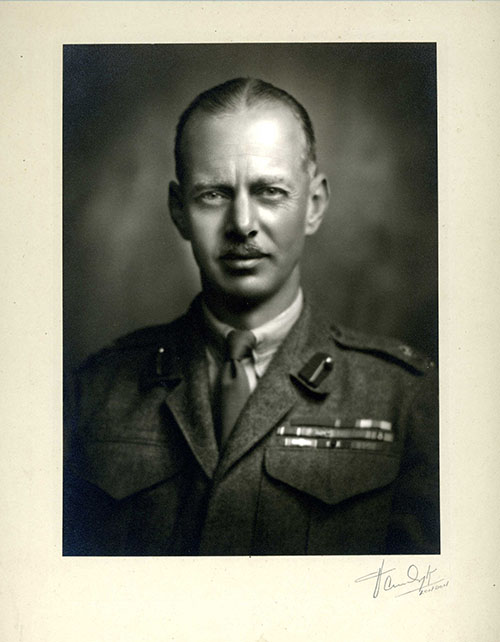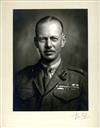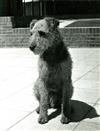Product Details
AN ORIGINAL, FRAMED IMAGE OF GENERAL SIR MILES DEMPSEY IN UNIFORM,
approx. 13in. x 9 1/2in. including mount and taken post D-Day by Vandyk studios of Buckingham Palace Road, together with an image of his fox terrier 'Bimbo'
Provenance:
General Sir Miles Dempsey G.B.E., K.C.B., D.S.O., M.C. was, unarguably, one of the very finest senior Allied officers of the Second World War. His abilities were manifold and he was directly responsible for the success of several notable battles, and yet due to his restraint and modesty his name is not often to the fore in discussion. In addition, Dempsey did not commit his memoirs to paper unlike many of his fellow Generals. The following Lots show not only just how well thought of the man was by the senior staff but, far more importantly, will place a question mark beside the now accepted events in connection to the Battle for Caen and the subsequent allied advance to the Rhine.
All Lots are being offered at auction by the family, having been passed by descent to the vendor.
Miles Dempsey's older brother was the Clan Chief of the ancient O'Dempsey Sept and his ancestor Terence O'Dempsey was Knighted on the battlefield in Ireland by the Earl of Leicester in 1599 and later ennobled by King Charles 1st as Viscount Clanmaliera and Baron Philipstown.
Dempsey, known to his friends and close fellow officers as 'Bimbo' or 'Lucky', and latterly to his men as 'Two Hundred Miles' (following a period of rapid advance through Belgium), was born 15th December 1896 in the small resort of New Brighton in Cheshire. He was schooled at Shrewsbury before going to Sandhurst where he gained his commission in 1915 in the Royal Berkshire Regiment. He led his first command to France and the Western Front. Here he showed the first operational evidence of a mind possessed of great memory, an unsurpassed ability to interpret maps and not a little élan. In March 1918, he was gassed and subsequently had to have a lung removed. His efforts were formerly recognised in June 1919 when he was awarded the Military Cross for bravery.
His military career advanced rapidly by peacetime standards in the inter-war years. Sensing that a further war was likely with Germany he spent many inter war holidays touring France and the Low Countries by bicycle to familiarise himself with the geography of what he felt sure would be future battlegrounds. By the time war broke out in 1939 he was already a Lieutenant Colonel, and C.O. of the 1st Battalion, Royal Berkshire Regiment. By the November of that year he was promoted to command the 13th Infantry Brigade which formed a part of the ill-fated British Expeditionary Force in France. The B.E.F.'s splendid evacuation from Dunkirk needs no expansion here except to note that as the Germans advanced swiftly and encircled the retreating allies, Dempsey's unit fought a fierce rear-guard action that bought precious time for the men at the beach-head. He was awarded the D.S.O. for his part in the evacuation.
Described as a 'career infantryman', Dempsey then went on to command the 42nd Armoured Division. This was formed from various infantry units which were then equipped, as the title suggests, in an armoured role. He then transferred in the December of 1942, to take-over command from Lt.-Gen. Horrocks of the illustrious XIII Corps, formerly known as the Western Desert Force and part of the British 8th Army in North Africa. Montgomery's push west with the 8th Army struck a decisive blow and, together with the Allied Torch landings and subsequent advance eastwards, effectively pushed the Germans out of the southern Mediterranean. With the campaign in North Africa drawing to a close, Alexander appointed Dempsey in a key planning role for the invasion of Sicily before he once more took command of XIII Corps for the actual invasion, which at the time was the largest such undertaking in history. The experience Dempsey gained in the use of combined operations was to stand him in great stead when he led the British 2nd Army at D-Day. It was at this time that he first encountered the Special Raiding Squadron - forerunners of the S.A.S. His role in saving the S.A.S. as an independent force was later recognised in Dempsey becoming the regiment's first Colonel Commandant.
The taking of Sicily represented a major turning point in the war; for the first time the Axis powers were being driven back in Europe, important sea lanes were opened for the first time since 1941 and the operation's success led the way to Mussolini being toppled from power. Operation Husky began on the night of 10th July 1943, and Dempsey led the British, Indian and Canadian assault on the southern beaches. The campaign officially ended 17th August with the allies now looking directly across the Strait of Messina at their next challenge.
Less than a month later, Montgomery and Dempsey led the 8th Army across the Strait and stormed the beaches at Calabria and Taranto before sweeping north to link-up with the American 5th Army at Salerno. The Italian Campaign took a great toll on both sides and the allies met with fierce resistance from both the Italians and Germans. The former rather surprisingly as the coup that had deposed Mussolini initially sought to broker a peace. This, however, was the end of Dempsey's sojourn in southern Europe as a signal from Montgomery brought him back to England to take command of the huge 2nd Army. This, of course, was in preparation for Operation Overlord, the establishment of an allied lodgement in France, and both Montgomery and Eisenhower knew that Dempsey should be instrumental in the planning and execution of it.
Operation Neptune, D-Day, was delayed by 24 hours due to weather and sea conditions but on 6th June 1944 the allies landed 160,000 men along the northern Normandy beaches (by the end of August that figure had risen to over 3,000,000). Dempsey's initial objective was to capture the medieval city of Caen, a strategic hub much-prized by the Germans. History has recorded that the British and Canadian's advance stalled at Caen causing some impatience amongst the American senior staff as their forces broke out of Bocage country heading south and east. Montgomery especially was subject to some rather harsh, and largely unwarranted criticism. However, a perfectly laudable alternative is under-pinned by some of the items offered for sale. The allies knew that Caen was heavily defended by some of Hitler's best units, including several SS-Panzer Divisions (some of which were on rest after being transferred from the east). By attacking the city, not only would these units be pinned-down but it would also draw in the infantry and light armoured units on the west side of the peninsula, thus allowing the Americans to break-out. The top brass at S.H.A.E.F. knew the 2nd Army would be held back for a time, but they also knew that Caen must be taken. It was already a transport hub, with roads and waterways, but the flat land surrounding much of it was ideal for landing grounds. Milton Shulman, a Canadian Intelligence Officer, wrote of Dempsey's plan of battle, "What better justification for the strategy adopted by allied planners to attract to the anvil of Caen the bulk of German armour, and there methodically hammer it to bits!" The irony in finally capturing what had been the ancient capital of the Norman Empire was not lost on Dempsey for in 1173, his ancestor Dermod O'Dempsey had notably defeated the famous Norman General Strongbow in Offaly, an engagement that kept the invaders out of Dempsey lands for three hundred years.
With Caen finally taken by mid-August the 2nd Army swept south-east towards the Falaise Gap with the rapidly advancing American 1st Army to their south. The battered German Army Group B was effectively enveloped in the Falaise - Chambois pocket after Hitler had ordered a counter-offensive rather than a tactical withdrawal. The Germans fought tenaciously but their losses were huge, and what little remained of the group began to retreat east of the Seine. This allowed the Allies almost clear access to France's border with Germany, and with the liberation of Paris Operation Overlord was complete. Always a modest man, Dempsey had driven many allied efforts without ever taking the limelight. His efforts had not gone unrecognised though. King George VI paid a visit to the 2nd Army in October and on the 15th asked for a sword, and dubbed Dempsey as a Knight in the Most Honourable Order of the Bath. This was an honour indeed; the last time a reigning Monarch had knighted someone on the field of battle was at Agincourt in 1415. Thus for the second time in over three hundred years a Dempsey had been awarded a Knighthood on the actual field of battle.
With France liberated and the Vichy administration put down, the allies turned their eyes north-east to the Rhine and Germany's sea ports. By the December of 1944 the allied line had reached the Ardennes region of Belgium when a major counter-offensive was launched against them. The attack was a complete surprise and a large salient was formed in the allied line, with the Americans taking the brunt of the fighting. It was a bitterly cold winter with the Armies under General Bradley's command operating under extreme and testing conditions. Counter attacks and offensives followed by both sides and it was fast developing into a situation of attrition. With failed communications between Bradley and the American 1st and 9th Armies (who had also lost contact with the entire U.S. command structure), Eisenhower placed Montgomery in command. In turn the leadership fell to Dempsey who temporarily took command over General Courtney Hodges' 1st Army and General William Simpson's 9th Army. Montgomery, though a great man, could be both caustic and arrogant, and was not well-received by many of the American Generals, but Dempsey got along very well with most of them (Simpson and Ridgeway especially) and the alliance proved effective in grinding down the German advance, which was ended by mid-January 1945. The battle exacted a heavy toll on both Americans and Germans but victory paved the way for an assault on the River Rhine.
Operation Plunder began at night on 23rd March with four thousand allied guns opening fire on Wesel and the surrounding area accompanied by R.A.F. Bomber Command with an aerial bombardment, all watched by Churchill who was at Montgomery's Tactical HQ. Dempsey led the 2nd Army and U.S. 9th Army and the Rhine was crossed at Rees with a bridge-head being formed against a possible counter-attack by General Schlemm's 1st Parachute Army. The operation was a complete success and Dempsey was the first senior British officer to cross the river on a quickly erected Bailey bridge. By now German resistance, though courageous, was crumbling and Dempsey advanced quickly taking the strategically important ports of Bremen, Hamburg and Kiel (ending safe haven for the U-Boats).
On 3rd May at 1100 a delegation of senior German officers arrived at Dempsey's Tac HQ led by Gen. Admiral von Friedeberg. It soon emerged that they were representing General Keitel and Admiral Donitz (themselves representing Army and Naval forces) who wished to surrender. It is recorded that true to form, Dempsey dismissed them with instructions to report to his superior officer. So it was that next day the Germans formerly surrendered in North West Europe to Montgomery at L?neberg Heath.
Total surrender, and the end of hostilities in Europe, took place on 8th May and Dempsey bade farewell to his beloved 2nd Army in August. From here he moved to command the British 14th Army as G.O.C-in- C. Malaya Command, and from there to Land Force Commander, South East Asia. The Japanese surrendered soon after and Dempsey's post-war career quickly took shape. It was during this time that he began working closely with Lord Mountbatten, who was the final Viceroy of India at the time, and the two men became firm friends.
He was made a full General in 1946 and placed as C.-in- C. Middle East Land Forces. Back in England, Montgomery was already decided upon who should succeed him as Chief of the Imperial General Staff - C.I.G.S. - and this was his trusted subordinate. Dempsey had other ideas however, and had already decided to retire from the Army. His decision was met by a great deal of earnest beseeches to reconsider, including from Mountbatten who wrote, "I hope you will allow an unbiased person to tell you that your departure would be nothing short of a National disaster, as I honestly consider that you are in a class by yourself, on whom the future of the Army must, to a very large extent, ultimately depend." A great accolade from a great man.
Dempsey made good his decision to retire, although he lent his experience to post war governments in the planning for any subsequent wars. In 1951, he was appointed Shadow Commander-in-Chief UK Land Forces and commenced planning for yet another major conflict. Honours and awards were bestowed on him from a number of countries and though he accepted them with full gratitude, his modesty was always to the fore. As many of his military peers were publishing their memoirs, Dempsey instead pursued his love of horses and turned his back politely on fame, writing in his will that his wartime diaries be burned.
He retired to Berkshire newly married, and enjoyed a life bringing-on jump horses (he was Chairman of the Race Course Betting Board) He later became Regimental Colonel of three military families; the S.A.S., the Royal Military Police and his beloved Royal Berkshire Regiment.
Pericles wrote circa 450 BC that "freedom is the sure possession of those alone who have the courage to defend it". On that basis, when General Sir Miles Dempsey died on 5th June 1969, he was most certainly a free man.
Please click HERE to view Terms & Conditions.
Estimate £100-150



